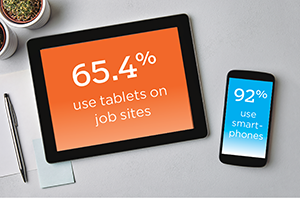Construction industry's technology adoption is analyzed

|
In October, Construction Dive analyzed general contractors' responses to the JBKnowledge 2018 ConTech Report to determine whether progress is being made regarding technology adoption in the construction industry.
Of 786 respondents, 41.5 percent indicated their companies' attempts to adopt technology are limited by lack of staff that can support new technology. In addition, 40.7 percent indicated their companies' budgets are a limiting factor, and 33.2 percent said hesitant management limits technology adoption.
More than one-third of respondents (35.4 percent) said their companies have two to five people on staff who research and implement new technologies full-time; however, 27.1 percent of participants responded that no one at their companies occupies that role.
Forty-nine percent of respondents said their companies have a technology research and development budget, and 51 percent said their companies do not. Reasons given for not having a research and development budget included it being unimportant; important but not a priority for management; and the processes to launch technology are still new or developing.
More than 92 percent of respondents said they use smartphones on job sites, and 65.4 percent use tablets. Additionally, about 57 percent of respondents report their firms use drone technology. Meanwhile, some contractors continue to avoid building information modeling (BIM), with 28 percent of respondents saying their companies do not bid on projects involving BIM. Fifty-nine percent of respondents are using BIM for coordination and clash detection, followed by project visualization, project planning and virtual mockups.
Regarding technologies that have not yet become commonplace, respondents are most excited about augmented, virtual and mixed reality, with about one-third of respondents saying they believe these technologies will give their firms a strategic advantage. About 32 percent selected prefabrication, followed by job-site sensors, robotics, machine learning and artificial intelligence.
All respondents said their firms use multiple software applications across workflows, but nearly a quarter of respondents said there are no integrations across platforms. In fact, about 53 percent said employees must manually transfer data across applications; about 47 percent said they transfer data via spreadsheets; and nearly 28 percent transfer data via custom-built integrations.
ICC welcomes new board of directors

|
The International Code Council (ICC) welcomed a new slate of officers and directors to its board of directors during ICC's Annual Conference in October. The board of directors sets ICC's strategic direction and acts as the voice of ICC's membership.
William R. Bryant, assistant director of inspections and permits for Anne Arundel County, Annapolis, Md., is president; Greg Wheeler, chief building official for the City of Thornton, Colo., is vice president; and Cindy Davis, deputy director of the Division of Building and Fire Regulation at the Virginia Department of Housing and Community Development, Richmond, is secretary/treasurer. Jay Elbettar, building safety manager for the City of Lake Forest, Calif., is immediate past president.
"We are grateful to have a board of directors with such extensive expertise in the building safety industry," says Dominic Sims, ICC's CEO. "These directors volunteer their time to make our buildings safer and our communities more resilient."
A complete roster of ICC's board of directors is available at www.iccsafe.org/about-icc/leadership.
COMMENTS
Be the first to comment. Please log in to leave a comment.